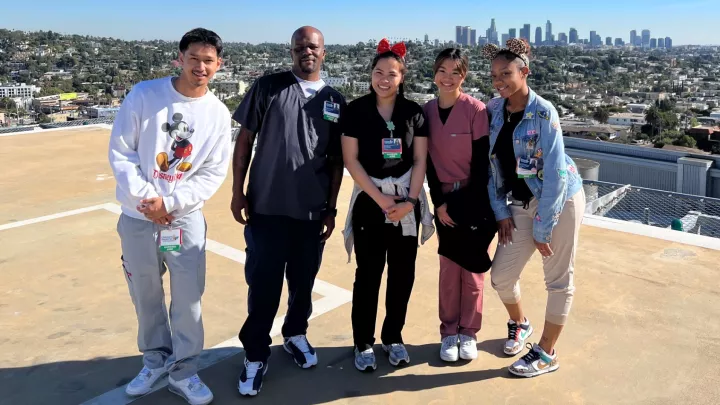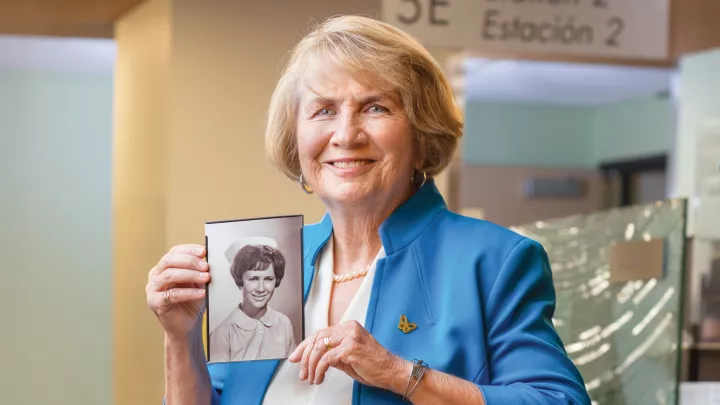
CHLA’s Revitalize Program Is Helping Team Members Preserve Their Mental Health
Though COVID-19 deserves its bad name, it didn’t invent stress and anxiety in the health care field. It merely accelerated it. Beth Fitzpatrick saw the need for solutions a decade ago.
“Before we ever got to the pandemic, sustainability of the health care workforce was a concern of mine,” she says.
It was in 2013 that Fitzpatrick, LCSW, Manager of the Employee Assistance Program at Children’s Hospital Los Angeles, attended a meeting at the Trauma Resource Institute on how to support people under stress. At the crux of the organization’s Community Resilience Model was a method of controlling one’s internal reactions to a traumatic or antagonizing situation.
Fitzpatrick was drawn to the science behind it, as the model teaches people to allow the calming parasympathetic nervous system to basically overrule the agitated sympathetic nervous system during a crisis. She thought it was a natural for the health care setting.
“It’s all biology,” she says. “The whole time I was there, I kept thinking, ‘Oh man, I need this packaged for 5,000 people and I need it yesterday.’”
Her thoughts matched with CHLA’s organizational effort to prioritize the welfare of its team members through the Office of Well-Being (see sidebar, below). Applying the Community Resilience Model, Fitzpatrick crafted a resilience training program that she named Revitalize because of the way the base word connects with frontline workers. “They are vital parts of the organization,” she says. She also added a “train the trainers” component so interested team members could assist in conducting sessions and improving employee well-being.
A giant boost to the program came in 2021, when Fitzpatrick was awarded a $2.1 million federal grant to help combat the severe toll the pandemic was taking on the mental health of front-line hospital workers, causing droves to leave the profession. The landslide of new tasks and pressures and considerations “was just too much,” Fitzpatrick says.
“It’s like you’re on a ‘crazy train’ and you feel like you can’t control your thinking. You’re so anxious all the time. ‘We’re having a surge again. Oh, we’re getting better. But now we have monkeypox? Are you kidding me?’ Kids at home, not in school, and crowding in the house and people using the computer in the bathroom because there was no other space. Just the enormity of the things that people had to endure. And we never stopped to say, ‘God, look at what just happened.’ We all just kept working.”
The secret sauce of wellness
The antidote Fitzpatrick offers comes in one sitting: six wellness skills that provide people the means to counteract their instinctive negative response to stress so they can remain stable and productive. Fitzpatrick teaches the skills in a condensed one-hour version, to give people an “appetizer exposure,” she says, or in a comprehensive four-hour session, which she encourages so you get the full menu.
“The four-hour session is the secret sauce of the whole thing,” she says. “We talk about big traumas in the world and at work, little traumas in the world and at work, and cumulative traumas—the things that lead to burnout. We talk about where they show up on our body—all of it.”
One of Fitzpatrick’s resilience training converts is Sarah Strawn, a registered nurse in the Sleep Center. Strawn was so taken by the one-hour Revitalize session that she enrolled in the four-hour session and then completed the train-the-trainer program so she could pass the skills on to her coworkers. Like Fitzpatrick, Strawn was drawn to the biology behind the model.
“It’s neuroscience,” she says. “When you think about something pleasant, your body experiences that pleasantness. I think of the sensation of water on my feet. That's something I'm doing with my brain, but it’s affecting my body, that overall feeling of calm. It's nervous system self-regulation.”
She gives a rundown of the six wellness skills, citing examples of how she uses them. One, called grounding, helps to steady her. Strawn explains that grounding is the use of a solid surface to secure your body, such as sitting in a chair.
“You're safe, you're supported,” she says. “If I'm in a room with a patient and they're agitated or upset, instead of having that affect me, I can ground myself. I lean up against the wall to bring myself back into the present, to calm myself down, saying, ‘This is OK.’ Then I can go ahead and engage with them.
“We talk a lot about self-care, but how do you do that? Because if we don't take care of ourselves, we can't take care of our patients.”
Altering your perspective
Like Strawn, Swati Saiben, a nurse coordinator in the Cancer and Blood Disease Institute, went through the five-day course to become a Revitalize trainer. Her introduction to the Community Resilience Model came from her own therapist after the onset of the pandemic.
“I realized I needed some skills to help me because things were getting hard,” Saiben says. “Coming on the unit knowing we're short-staffed, knowing we have high-acuity patients, those things would continue to pop up in my mind. I was short with people because I was holding on to a lot of that inside of me. Sometimes your unpleasant sensations are more apparent and easier for you to get stuck in.”
The training taught her that she had to reconsider and reframe the adversity at hand.
“Like, ‘It’s true, we're short-staffed today. Yes, we do have really hard cases today. But what else is true?’ It helped me not stew about it. I was able to shift my perspective.”
Saiben says she can see resilience training working even in the quick five-minute sessions held at CHLA’s wellness fairs, where team members pop in casually as they graze the various booths, but after five minutes leave inspired.
“People feel validated, with the shared acknowledgement that what we do here is hard and that we need to take care of ourselves. ‘Yes, we need this. I need this.’”
Like, ‘Wow, this really works’
Fitzpatrick faces some stubborn biases trying to promote the value of resilience training. For starters, there’s the “hopscotch in semantics” she says she does to avoid the terms resilience and training, which suggest to health care workers that they have some deficit that needs work. “It’s like, don’t make me feel like I need to fix myself,” she says.
Plus, training implies that it’s mandatory and a chore. In fact, it’s neither. Revitalize sessions are entirely voluntary—and the sessions are portable. Fitzpatrick conducts them at departmental staff meetings, hospital wellness fairs, or whatever CHLA location is convenient to the participants. She goes where she’s invited.
“I come to people where they are,” she says, and that includes everyone at CHLA, not merely doctors and nurses.
“We’re supporting anybody wearing a butterfly badge. Yesterday’s session, two people were from the Emergency Department, one was from 6 East, and the other was from Hematology-Oncology. I don’t know that they knew each other before they came in, but they walked out knowing each other.”
Likewise, the 27 trainers assisting Fitzpatrick come from across the hospital. “I have nurses, doctors, chaplains, social workers. I even have a guy in IT who got trained, which I love. Who doesn’t want throw their computer off the roof when you’ve had enough trouble? Now you have a guy who can help settle you down.”
Any resistance Fitzpatrick encounters at the start of a session is virtually gone by the end of it. Surveys confirm that. When asked to rate the session, 462 participants scored it a 4.7 out of 5, and 77% said they left Revitalize feeling better able to manage stress.
Strawn has had the same experience at the wellness fairs, as people arrive skeptical and after sampling the resilience skills are all in. “You can see their face light up, like, ‘Wow, this really works,’” she says. “I have really seen it impact people, if they are open to it.”
“Sometimes these skills have been described as infantile, that they’re too simple,” Fitzpatrick says. “Thank god they’re simple because we don’t have room for a lot. It’s biology based, so you don’t have to learn a whole new language.”
Fitzpatrick says the pandemic forced us to stop grinding away in silence and to look after ourselves if we wanted to get through it.
“To have a sustainable workforce, we have to look at things differently,” Fitzpatrick says. “It can’t just be the way things have always been: Put your head down and keep working until you fall over. We can take care of ourselves by self-regulating. The stuff that people can learn is hugely empowering and instant. And they can see it and feel it once they start to use the skills.”
The Office of Well-Being
Revitalize is one of a roster of offerings team members can access through Children's Hospital Los Angeles’ Office of Well-Being, which also includes:
- HeaRT (Healing Response Team): A peer support program providing 24-hour in-person guidance for any team member experiencing a normal reaction to a stressful event
- ESS (Emotional Support Services): Confidential individual sessions with a licensed mental health professional
- Cumulative Stress Debriefings: Peer-led support groups covering numerous themes, including compassion fatigue, moral distress, burnout, grief and loss
- Schwartz Rounds: A forum series in which team members discuss the human, emotional and social aspects of caring for patients


